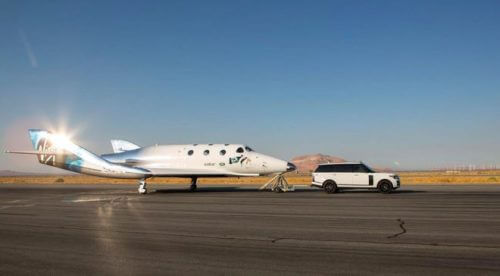
Virgin Galactic is preparing to resume flight testing of its suborbital space plane. On August 1, the company reported that it had received a license to conduct these tests from the US Federal Aviation Administration (FAA). As you may remember, in October 2014, a Spaceship 2 spacecraft crashed and one of its pilots was killed during landing practice. At the beginning of 2016, the company announced that it had built a new and improved UNITY VSS model
The license covers test flights of a spacecraft from California's Mojave Desert Air and Space Base over a period of several years. For these experiments, the spacecraft will be launched into the air by a carrier aircraft, WhiteKnightTwo, from which it will be released and fire a hybrid rocket engine that will bring it into suborbital flight, after which it will glide back to the landing track.
The license prohibited Virgin Galactic from flying official flights into space until it had successfully tested the combined performance of the spacecraft and the carrier aircraft. "The verification must include test flights, and the results must be submitted to the FAA before a space mission with human participants." The license was written.
Virgin Galactic agreed to receive the launch license with these restrictions. Such permits allow testing of reusable suborbital launch vehicles under a more streamlined regulatory environment, but prohibit the holding company from using the permit for any commercial application. Competing company Blue Origin has experimental approval for suborbital test flights of its New Shepard vehicle.
Scaled Composites, the company that developed Virgin Galactic's first spacecraft, had experimental approval from the FAA for its test flights. Before the crash in October 2014 in a test flight that destroyed the spacecraft and killed its co-pilot, it planned to make a series of such flights before handing the vehicle over to Virgin Galactic, which applied for a launch license for a commercial spacecraft.
One of the advantages of the launch license is that the license will allow Virgin Galactic to fly cargo, such as trials, for charterers before full-fledged commercial operations begin. Will Pomeranz, Vice President of Virgin Galactic, said that the company is considering flying cargo for test flights, although there is no certainty that these cargo will generate revenue for the company.
The announcement of the launch license came the same day as Virgin Galactic said it would begin ground testing of the second spacecraft, known as the UNITY VSS. The spacecraft performed a first test in which it was towed outside the hangar to evaluate and calibrate the navigation, communication and telemetry systems." was written in the company's announcement.
More than a year after the crash of the spaceship 2, Virgin Galactic unveiled the new model of the spacecraft, which will take tourists to the edge of space
Killed and seriously injured in the crash of Virgin Galactic's Spaceship-2 spacecraft during a test flight

5 תגובות
SPACEX's spacecraft looks a little more serious. NASA's Orion program is beautiful but spread over too many years. Every 5 years it can fall.
But they don't have an engine...
The matter is this: in the last test flights of SPACESHIP2 before it crashed, it turned out that the hybrid engine on which we had high hopes was simply too weak! The tool that was dropped from a height of 15 km was supposed to climb to a height of 100 km and more (the threshold of space) and instead it rose to a height of only 30 km and then it ran out of fuel....
They did not find a solution to the engine issue and hoped to find a more exotic fuel with a higher specific impulse, but it was not found.
The company is constantly trying to "maintain the expectations" (MAINTENANCE OF EXPECTATION) of the investors and the passengers who have already paid for the special flight (and there are no shortage of such). And each time they post some other happy message
Which is not relevant at all. And among us shows no practical progress in experiments. Like this post….
Mr. Branson doesn't know how to get out of his adventure and is waiting for "either the dog to die or the freak to die or both together"...
If the Orion plan (?) for a trip to Mars is cancelled, the world is in a wretched period in terms of space exploration. If space exploration costs 400 billion dollars (I threw out a number), then the obvious way is for all the countries that work separately to unite and share information. Sharing the information is the barrier to my understanding. An economic arms race is the issue.
Passenger planes lift chickens and not spaceships for interstellar travel.